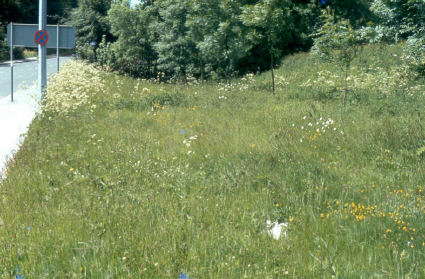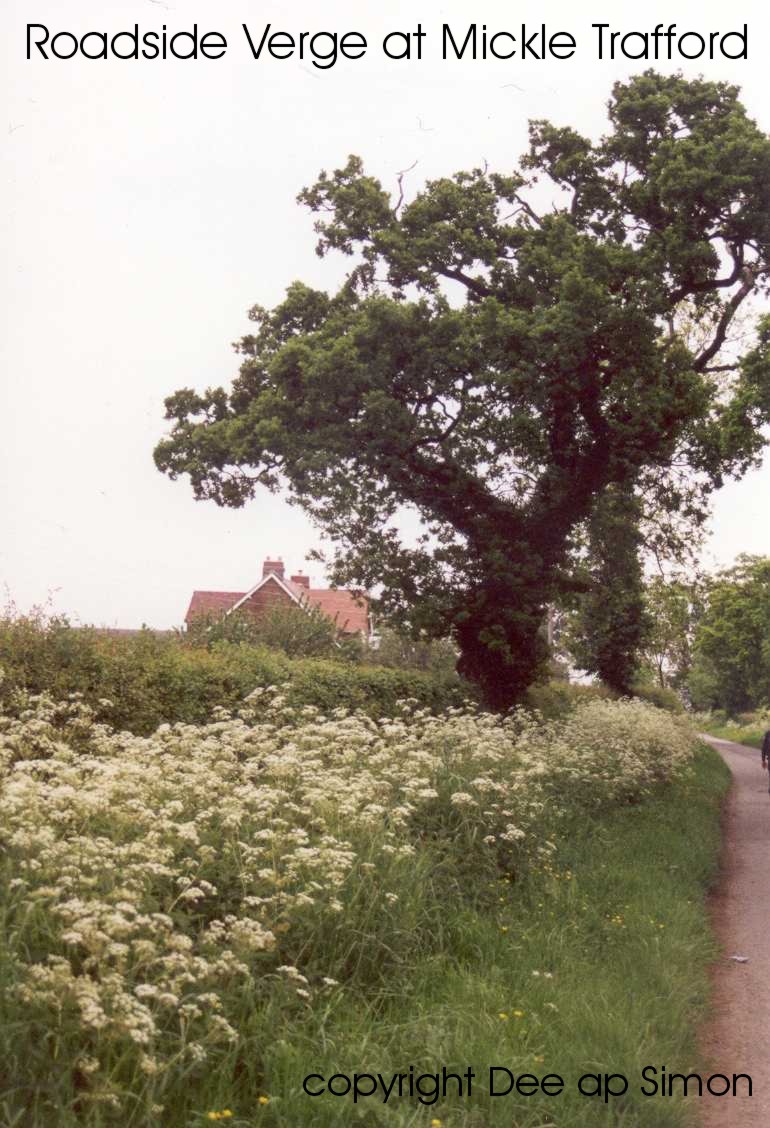ROADSIDE VERGES
LOCAL BIODIVERSITY ACTION PLAN
 Links to associated SAPs
Links to associated SAPs
None
Current Status
The 3,200 kilometres of roads in the Cheshire region provide a valuable wildlife resource and contribute to the wildlife corridor network. A small proportion have retained fragments of unique habitat from an earlier period whilst new verges have provided the opportunity for both created and pioneering plant communities. In 1973 a survey of verges identified 80 sites of nature conservation interest with 8 sites listed as of national importance. Presently 4 roadside verges are included in the County Council register of Sites of Biological Importance (SBI).
In a 1995 Cheshire Roadside Verge Survey 115 sites were included, with a number of previously unrecorded sites being identified in Chester City Council's Nature Conservation Audit. Of the 8 sites listed in 1973 one has been largely lost to abuse/ fly tipping; at another three sites the unique flora was not traced; at two sites the extent of meadow cranesbill is still evident and the remaining two sites retain a locally diverse flora. Of the 85 sites surveyed in 1995, 30 sites may be considered for SBI status. In addition there are 33 SBIs adjacent to roads where a survey of the verge would be appropriate.
All road verges are maintained to a minimum standard to comply with safety requirements. In 2002 Cheshire County Council will take over responsibility for Trunk Roads, currently maintained by the Highways Agency. Ragwort is dealt with by hand pulling in areas where a particular problem is identified
Of these 18 sites with an area greater than 1ha, 15 have SSSI status and so are managed by an association between individual landowners and English Nature. In addition, the Dee Estuary and a smaller area of reedbed (Frodsham Marsh) have held international and European status, being designated as RAMSAR sites since December 1995, and Special Protection Areas under the 1979 EC Habitats Directive, respectively. Bound by the EC Directive the government is required to take special measures to conserve the habitat of rare, vulnerable and/or regularly migrating species.
 Threats
Threats
- The timing of cutting which may prevent the setting of seed.
- Cuttings being left in situ, which may increase soil nitrate and encourage coarser species.
- Erosion caused by vehicle intrusion.
- Tipping.
- Inappropriate/unsympathetic reinstatement.
- Scrub invasion on wider verges leading to a loss in biodiversity.
- Invasion of problem species (ragwort, giant hogweed).
- Planting of non-native species.
- Inadvertent spreading of road salt onto verges
- Inappropriate use of herbicides.
How are we helping to conserve Roadside Verges in the Cheshire region?
-
In rural areas, verges are cut to one swathe width adjacent to the carriageway, twice per annum, with allowance for visibility splays as necessary.
-
In urban areas, verges are cut more frequently to maintain a sward height between 12 - 75mm, and cuttings are generally removed.
-
Allowance for cutting around street furniture, cutting embankments to alleviate fire risk, cutting adjacent to footpaths etc. is included in the maintenance schedule.
-
District Highways Engineers are responsible for the maintenance schedule for rural verges and can vary this as appropriate on a verge by verge basis.
-
Appropriate verge treatment is taken into consideration in new Cheshire County Council Highways Schemes
Objectives, Targets and Actions
OBJECTIVES |
LOCAL TARGETS |
- To identify, maintain and enhance old roadside verges with characteristic local flora.
To promote the importance of roadside verges as wildlife habitat by encouraging sympathetic new planting and management regimes.
|
|
ACTION REQUIRED |
-
Form a Local BAP Action Group for verges.
-
Develop a systematic survey to give an insight into the Regional resource.
-
Formulate a cost-effective scheme for marking and maintaining special verges.
-
Agree a best practice code for reseeding/planting of verges for biodiversity in different habitats.
-
Create a bid for funding to implement the best practice code.
-
Produce a leaflet for the benefit of elected representatives and the general public.
-
Provide copies of individual verge surveys to the local community.
-
Involve local communities in monitoring their special verge and encourage them to recognise other sites in their locality.
-
Consider the addition of more verges into the SBI register using the 1995 data.
-
Include verges in surveys of adjacent wildlife sites.
-
Provide advice on maintenance contracts for future verge management.
-
Provide advice at the design stage for new road schemes
|
Progress so far
Contact details
| LBAP Chair |
Mike Wellman, Cheshire County Council
Phone: 01244 603195 |
References & Glossary
HMSO (1995): Biodiversity: The UK Steering Group Report, Volume 1: Meeting the Rio Challenge, London.
HMSO (1995): Biodiversity: The UK Steering Group Report, Volume 2:Action Plans, London.


 Links to associated SAPs
Links to associated SAPs  Threats
Threats